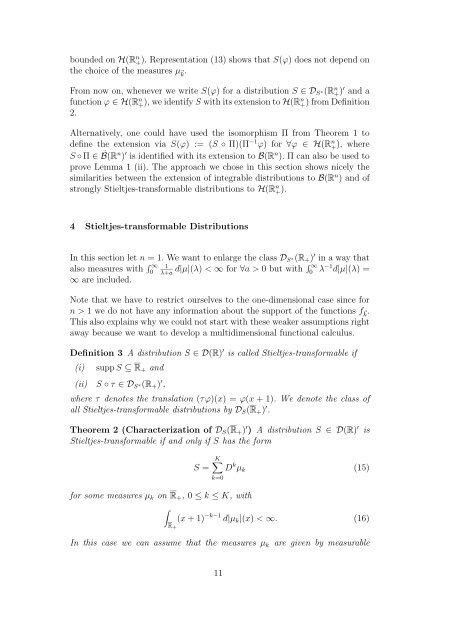The Stieltjes convolution and a functional calculus for non-negative ...
The Stieltjes convolution and a functional calculus for non-negative ...
The Stieltjes convolution and a functional calculus for non-negative ...
You also want an ePaper? Increase the reach of your titles
YUMPU automatically turns print PDFs into web optimized ePapers that Google loves.
ounded on H(R n +). Representation (13) shows that S(ϕ) does not depend on<br />
the choice of the measures µ ⃗k .<br />
From now on, whenever we write S(ϕ) <strong>for</strong> a distribution S ∈ D S ∗(R n +) ′ <strong>and</strong> a<br />
function ϕ ∈ H(R n +), we identify S with its extension to H(R n +) from Definition<br />
2.<br />
Alternatively, one could have used the isomorphism Π from <strong>The</strong>orem 1 to<br />
define the extension via S(ϕ) := (S ◦ Π)(Π −1 ϕ) <strong>for</strong> ∀ϕ ∈ H(R n +), where<br />
S ◦Π ∈ B(R ˙ n ) ′ is identified with its extension to B(R n ). Π can also be used to<br />
prove Lemma 1 (ii). <strong>The</strong> approach we chose in this section shows nicely the<br />
similarities between the extension of integrable distributions to B(R n ) <strong>and</strong> of<br />
strongly <strong>Stieltjes</strong>-trans<strong>for</strong>mable distributions to H(R n +).<br />
4 <strong>Stieltjes</strong>-trans<strong>for</strong>mable Distributions<br />
In this section let n = 1. We want to enlarge the class D S ∗(R + ) ′ in a way that<br />
also measures with ∫ ∞ 1<br />
0 d|µ|(λ) < ∞ <strong>for</strong> ∀a > 0 but with ∫ ∞<br />
λ+a 0 λ −1 d|µ|(λ) =<br />
∞ are included.<br />
Note that we have to restrict ourselves to the one-dimensional case since <strong>for</strong><br />
n > 1 we do not have any in<strong>for</strong>mation about the support of the functions f ⃗k .<br />
This also explains why we could not start with these weaker assumptions right<br />
away because we want to develop a multidimensional <strong>functional</strong> <strong>calculus</strong>.<br />
Definition 3 A distribution S ∈ D(R) ′ is called <strong>Stieltjes</strong>-trans<strong>for</strong>mable if<br />
(i)<br />
suppS ⊆ R + <strong>and</strong><br />
(ii) S ◦ τ ∈ D S ∗(R + ) ′ ,<br />
where τ denotes the translation (τϕ)(x) = ϕ(x + 1). We denote the class of<br />
all <strong>Stieltjes</strong>-trans<strong>for</strong>mable distributions by D S (R + ) ′ .<br />
<strong>The</strong>orem 2 (Characterization of D S (R + ) ′ ) A distribution S ∈ D(R) ′ is<br />
<strong>Stieltjes</strong>-trans<strong>for</strong>mable if <strong>and</strong> only if S has the <strong>for</strong>m<br />
<strong>for</strong> some measures µ k on R + , 0 ≤ k ≤ K, with<br />
∫<br />
K∑<br />
S = D k µ k (15)<br />
k=0<br />
R +<br />
(x + 1) −k−1 d|µ k |(x) < ∞. (16)<br />
In this case we can assume that the measures µ k are given by measurable<br />
11



